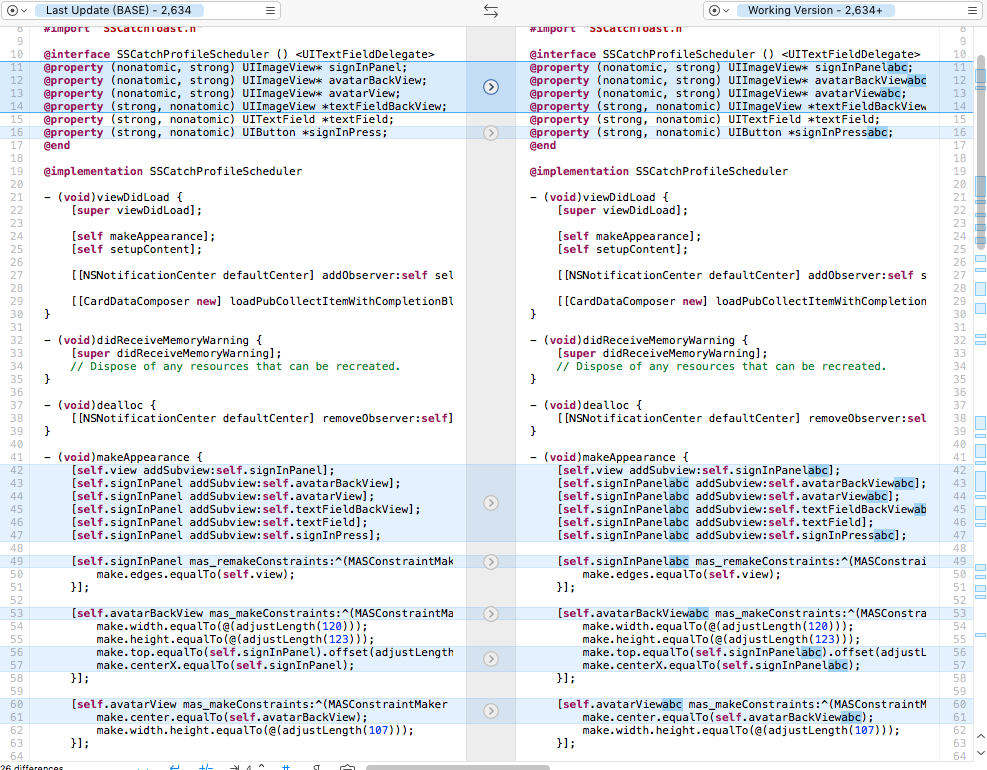背景
公司需要做一系列的殼版本,殼版本如果內(nèi)容雷同提交到App Store會有被拒絕的風險,除了我在上一篇文章中說道的在殼版本中注入混淆的代碼,防止被蘋果檢測到內(nèi)容太過雷同而導致審核被拒絕。還有另一種可行的方法是批量修改源文件中的類名、屬性、方法名稱等會在二進制文件中留下符號標記的信息,繞過蘋果的機器審核。
這篇文章介紹的是如何使用腳本批量修改屬性名稱,后續(xù)還有系列的包括使用腳本批量修改類名稱、方法名稱等信息的文章。
結(jié)果
下面是執(zhí)行腳本替換了屬性的結(jié)果圖,腳本把所有需要替換的屬性添加了abc后綴,當然依然是可以正常編譯運行的
源碼:https://gitee.com/dhar/YTTInjectedContentKit

分析
原理分析
objc代碼中的類名、屬性、方法、源文件路徑等信息最終會被打包到二進制文件中,保存在二進制文件中的.sym符號表段中,可以使用objdump -t命令查看二進制符號信息,以下的命令把objdump -t的結(jié)果寫入到文件InjectedContentKit_Example_Symbols中去。
objdump -t InjectedContentKit_Example > InjectedContentKit_Example_Symbols
文件的內(nèi)容會很大,所以選擇了幾個代表性的內(nèi)容說明:
0000000100026350 l d __TEXT,__text __text# 這里保存的是類源文件的路徑符號信息0000000000000000 l d *UND* /Users/aron/PuTaoWorkSpace/project/sscatch/DevPods/InjectedContentKit/InjectedContentKit/Classes/Composer/PubSearchDataComposer.h# 這里保存的是屬性對應的var信息0000000000000000 l d *UND* _OBJC_IVAR_$_TextCardItem._title0000000000000000 l d *UND* _OBJC_IVAR_$_TextCardItem._showReact0000000000000000 l d *UND* _OBJC_IVAR_$_TextCardItem._topChart0000000000000000 l d *UND* _OBJC_IVAR_$_TextCardItem._reaction# 這里保存的是屬性信息對應的getter方法信息00000001000264a0 l F __TEXT,__text -[TextCardItem title]00000001000264c0 l F __TEXT,__text -[TextCardItem showReact]00000001000264f0 l F __TEXT,__text -[TextCardItem topChart]0000000100026510 l F __TEXT,__text -[TextCardItem setTopChart:]# 這里保存的是屬性信息對應的setter方法信息00000001000028a0 l F __TEXT,__text -[SSCatchInviteScheduler setOrganizer:]00000001000028e0 l F __TEXT,__text -[SSCatchInviteScheduler setInputCardBack:]0000000100002920 l F __TEXT,__text -[SSCatchInviteScheduler setInputTextBack:]# 這里保存的是類文件的文件名信息0000000000000000 l d *UND* PubSearchDataComposer.m000000005a937587 l d __TEXT,__stub_helper __stub_helper00000001000251c0 l d __TEXT,__text __text
從上面可以看出,二進制中保留了很多信息和源代碼有很大關(guān)系,我們做個簡單的猜測蘋果后臺機器審查二進制的時候會通過二進制中的符號進行對比,如果兩個二進制(一個主版本、一個殼版本)代碼中的符號重合度超過某個閾值,就會判定這是發(fā)布殼版本的行為,而這是蘋果說不允許的,所以可行的方法是修改源文件中的這些信息來繞過蘋果的審查機制。
另外猜測蘋果應該是不會根據(jù)代碼中的流程控制來判斷的,因為二進制中的控制流程已經(jīng)是機器碼了,反編譯出來也就是匯編代碼,只要稍微做點改動二進制(.text段)就會變化很大。所以從這個方面來判斷就難度很大了。
步驟分析
主要有以下幾個步驟
這里說明下為什么第一步需要保存在配置文件中,因為第三步的操作有部分和第一步是相同的,所有這部分單獨出來一個模塊共用,都是輸入一個文件夾,最終保存在指定的文件中,后面的代碼中可以看到這部分。
實現(xiàn)
單步實現(xiàn)
1、尋找到需要替換的源文件中的所有的屬性,處理之后保存在配置文件中
這一步的功能是客戶端輸入一個需要處理的源碼文件夾,遞歸遍歷該源碼文件夾獲取所有源碼文件(.h .m 文件)。使用正則匹配找到屬性名稱,暫時保存到數(shù)組中,最后經(jīng)過黑名單過濾、去重過濾、其他過濾條件過濾,最終把待處理的屬性保存到客戶端輸入的輸出文件中。
可以分解為一下幾個小步驟
這部分功能的源碼如下:
文件名: GetAndStoreProperties.sh
該腳本在多個地方都有用到,所以作為一個單獨的模塊,定義了一些參數(shù),以適應不同的應用場景。在下面可以看到使用該腳本的地方。
#!/bin/bash######################### 腳本功能:從指定目錄獲取和保存屬性到指定的文件# 輸入?yún)?shù) -i 輸入的文件夾# 輸入?yún)?shù) -o 保存的文件# 輸入?yún)?shù) -f 使用黑名單和自定義過濾條件的參數(shù)# 輸入?yún)?shù) -c 自定義的黑名單文件############################### 參數(shù)定義param_input_dir=""param_output_file=""param_custom_filter_file=""param_should_use_filter=0####### 參數(shù)解析while getopts :i:o:c:f optdo case "$opt" in i) param_input_dir=$OPTARG echo "Found the -i option, with parameter value $OPTARG" ;; o) param_output_file=$OPTARG echo "Found the -o option, with parameter value $OPTARG" ;; c) param_custom_filter_file=$OPTARG echo "Found the -c option, with parameter value $OPTARG" ;; f) echo "Found the -f option" param_should_use_filter=1 ;; *) echo "Unknown option: $opt";; esacdone####### 配置# 屬性黑名單配置文件blacklist_cfg_file="$(pwd)/DefaultBlackListPropertiesConfig.cfg"####### 數(shù)據(jù)定義# 定義保存源文件的數(shù)組declare -a implement_source_file_arrayimplement_source_file_count=0# 定義保存屬性的數(shù)組declare -a tmp_props_arrayprops_count=0# mark: p384# 遞歸函數(shù)讀取目錄下的所有.m文件function read_source_file_recursively { echo "read_implement_file_recursively" if [[ -d $1 ]]; then for item in $(ls $1); do itemPath="$1/${item}" if [[ -d $itemPath ]]; then # 目錄 echo "處理目錄 ${itemPath}" read_source_file_recursively $itemPath echo "處理目錄結(jié)束=====" else # 文件 echo "處理文件 ${itemPath}" if [[ $(expr "$item" : '.*/.m') -gt 0 ]] || [[ $(expr "$item" : '.*/.h') -gt 0 ]]; then echo ">>>>>>>>>>>>mmmmmmm" implement_source_file_array[$implement_source_file_count]=${itemPath} implement_source_file_count=$[ implement_source_file_count + 1 ]; fi echo "" fi done else echo "err:不是一個目錄" fi}# 讀取源碼中的屬性,保存到數(shù)組中# 參數(shù)一: 源碼文件路徑function get_properties_from_source_file { local class_file=$1; echo "class_file=${class_file}" properties=$(grep "@property.*" ${class_file}) IFS_OLD=$IFS IFS=$'/n' for prop_line in $properties; do echo ">>>>>${prop_line}" asterisk_seperator_pattern="/*" if [[ ${prop_line} =~ ${asterisk_seperator_pattern} ]]; then # 從左向右截取最后一個string后的字符串 prop_name=${prop_line##*${asterisk_seperator_pattern}} # 從左向右截取第一個string后的字符串 seal_pattern=";*" seal_pattern_replacement="" prop_name=${prop_name//${seal_pattern}/${seal_pattern_replacement}} subsring_pattern="[ |;]" replacement="" prop_name=${prop_name//${subsring_pattern}/${replacement}} if [[ ${param_should_use_filter} -gt 0 ]]; then grep_result=$(grep ${prop_name} ${blacklist_cfg_file}) echo "grep_result = >>${grep_result}<<" custom_grep_result="" if [[ -n ${param_custom_filter_file} ]]; then custom_grep_result=$(grep ${prop_name} ${param_custom_filter_file}) fi if [[ -n ${grep_result} ]] || [[ -n ${custom_grep_result} ]]; then echo "--${prop_name}--存在配置文件中" else echo "--${prop_name}--XXX不存在配置文件中" tmp_props_array[$props_count]=$prop_name props_count=$[ props_count + 1 ] echo ">>>>>>>result_prop_name=${prop_name}" fi else tmp_props_array[$props_count]=$prop_name props_count=$[ props_count + 1 ] fi fi done IFS=$IFS_OLD}# 獲取目錄下的所有源文件,讀取其中的屬性function get_properties_from_source_dir { local l_classed_folder=$1 echo "獲取需要處理的源文件... ${l_classed_folder}" # 讀取需要處理目標文件 read_source_file_recursively ${l_classed_folder} echo "讀取源文件中的屬性..." for(( i=0;i<${#implement_source_file_array[@]};i++)) do class_file=${implement_source_file_array[i]}; echo "處理源文件:${class_file}" get_properties_from_source_file ${class_file} done;}# 把獲取到的屬性過濾之后寫入文件中# 過濾步驟包含去重、去掉簡單詞匯、去掉長度少于多少的詞匯# 如果在執(zhí)行的過程中遇到特殊情況,添加到黑名單配置(DefaultBlackListPropertiesConfig.cfg文件中添加配置)function post_get_properties_handle { local prop_config_file=$1 # 寫入文件中 echo "# Properties Configs" > ${prop_config_file} for key in $(echo ${!tmp_props_array[*]}) do # echo "$key : ${tmp_props_array[$key]}" echo ${tmp_props_array[$key]} >> ${prop_config_file} done # 去重 cfg_back_file="${prop_config_file}.bak" mv ${prop_config_file} ${cfg_back_file} sort ${cfg_back_file} | uniq > ${prop_config_file} # 過濾 if [[ ${param_should_use_filter} -gt 0 ]]; then mv ${prop_config_file} ${cfg_back_file} echo "# Properties Configs Filtered" > ${prop_config_file} IFS_OLD=$IFS IFS=$'/n' # 上一行的內(nèi)容 lastLine=""; for line in $(cat ${cfg_back_file} | sed 's/^[ /t]*//g') do if [[ ${#line} -le 6 ]] || [[ $(expr "$line" : '^#.*') -gt 0 ]]; then # 長度小于等于6或者注釋內(nèi)容的行不處理 echo "less then 6 char line or comment line" else if [[ -n ${lastLine} ]]; then # 上一行是非空白行 # 比較上一行內(nèi)容是否是當前行的一部分,不是添加上一行 if [[ ${line} =~ ${lastLine} ]]; then echo "${line} 和 ${lastLine} 有交集" else echo ${lastLine} >> ${prop_config_file} fi fi # 更新上一行 lastLine=${line} fi done IFS=${IFS_OLD} fi # 刪除臨時文件 rm -f ${cfg_back_file}}get_properties_from_source_dir ${param_input_dir}post_get_properties_handle ${param_output_file}使用以上腳本生成的配置文件 PropertiesConfigs.cfg 部分如下:
# Properties Configs FilteredUserRestrictionLabelaboutusButtonactivitySamplersaddAddressPressaddressSamplersaddressTextBoxappealPressappliedGroupedSamplersappliedSamplersapplyPressasyncArrayasyncListSampleraudioPlayer
2. 用戶自定義一個黑名單配置文件
在實踐的過程中,替換屬性的符號有時候會把系統(tǒng)類的屬性替換了,比如
對于這類問題,需要在黑名單中配置一些默認的過濾屬性,對于黑名單中的這些屬性不處理即可,在我的業(yè)務場景下,黑名單文件的配置如下:
文件名:DefaultBlackListPropertiesConfig.cfg
# BlackListPropertiesConfig.cfg# 屬性黑名單配置,在此配置文件中的屬性不需要替換名稱windownametitletitleLabellayoutappealSamplers
在 GetAndStoreProperties.sh 腳本使用到的代碼片段如下,其實就是使用了 grep 命來查找,判斷時候有找到,如果有就不處理,具體的可以看上面提供的完整的 GetAndStoreProperties.sh 腳本代碼
if [[ ${param_should_use_filter} -gt 0 ]]; then grep_result=$(grep ${prop_name} ${blacklist_cfg_file}) echo "grep_result = >>${grep_result}<<" custom_grep_result="" if [[ -n ${param_custom_filter_file} ]]; then custom_grep_result=$(grep ${prop_name} ${param_custom_filter_file}) fi if [[ -n ${grep_result} ]] || [[ -n ${custom_grep_result} ]]; then echo "--${prop_name}--存在配置文件中" else echo "--${prop_name}--XXX不存在配置文件中" tmp_props_array[$props_count]=$prop_name props_count=$[ props_count + 1 ] echo ">>>>>>>result_prop_name=${prop_name}" fielse tmp_props_array[$props_count]=$prop_name props_count=$[ props_count + 1 ]fi 3. 某部分需要隔離的代碼中的屬性生成黑名單配置文件
這部分的功能其實就是調(diào)用 GetAndStoreProperties.sh 這個腳本,最終把文件輸出的文件以追加的方式寫入到用戶自定義的黑名單屬性文件中。
#...# 黑名單類目錄declare -a custom_blacklist_search_dirscustom_blacklist_search_dirs=("/Users/aron/PuTaoWorkSpace/project/sscatch/sscatch/Classes/SSCatchAPI" "/Users/aron/PuTaoWorkSpace/project/sscatch/sscatch/Classes/Categories" "/Users/aron/PuTaoWorkSpace/project/sscatch/sscatch/Classes/Components" "/Users/aron/PuTaoWorkSpace/project/sscatch/sscatch/Classes/External" "/Users/aron/PuTaoWorkSpace/project/sscatch/sscatch/Classes/HandyTools" "/Users/aron/PuTaoWorkSpace/project/sscatch/sscatch/Classes/Macros" )# ...# 屬性黑名單配置文件custom_blacklist_cfg_file="$(pwd)/CustomBlackListPropertiesConfig.cfg"# ...# 獲取自定義的黑名單屬性并保存到文件中echo "" > ${custom_blacklist_cfg_file}for (( i = 0; i < ${#custom_blacklist_search_dirs[@]}; i++ )); do custom_blacklist_search_dir=${custom_blacklist_search_dirs[${i}]} ./GetAndStoreProperties.sh / -i ${custom_blacklist_search_dir}/ -o ${custom_blacklist_cfg_tmp_file} cat ${custom_blacklist_cfg_tmp_file} >> ${custom_blacklist_cfg_file}done#...最終生成的用戶自定義的黑名單文件部分如下
文件:CustomBlackListPropertiesConfig.cfg
# Properties ConfigsDBFilePathValidityStringaccessQueueageattributedNameStringavatarURLStringavatarUrlStringbackColorStringbodySchedulerbodyViewcatchDateStringcellHeightchannelKeycityNameconditionString# ....
4. 把需要替換的源文件中的所有匹配的屬性做批量的替換
這一步在前面三部的基礎(chǔ)上,查找并替換源碼目錄中在 PropertiesConfigs.cfg 配置文件中出現(xiàn)的屬性和屬性的引用,查找使用grep命令、替換使用了sed命令。腳本代碼如下
#!/bin/bash# 屬性重命名腳本####### 配置# classes類目錄classes_dir="$(pwd)/../InjectedContentKitx"# 黑名單類目錄declare -a custom_blacklist_search_dirscustom_blacklist_search_dirs=("/Users/aron/PuTaoWorkSpace/project/sscatch/sscatch/Classes/SSCatchAPI" "/Users/aron/PuTaoWorkSpace/project/sscatch/sscatch/Classes/Categories" "/Users/aron/PuTaoWorkSpace/project/sscatch/sscatch/Classes/Components" "/Users/aron/PuTaoWorkSpace/project/sscatch/sscatch/Classes/External" "/Users/aron/PuTaoWorkSpace/project/sscatch/sscatch/Classes/HandyTools" "/Users/aron/PuTaoWorkSpace/project/sscatch/sscatch/Classes/Macros" )# 配置文件cfg_file="$(pwd)/PropertiesConfigs.cfg"# 屬性黑名單配置文件blacklist_cfg_file="$(pwd)/DefaultBlackListPropertiesConfig.cfg"# 屬性黑名單配置文件custom_blacklist_cfg_file="$(pwd)/CustomBlackListPropertiesConfig.cfg"custom_blacklist_cfg_tmp_file="$(pwd)/TmpCustomBlackListPropertiesConfig.cfg"# 屬性前綴,屬性前綴需要特殊處理class_prefix=""# 屬性后綴class_suffix="abc"# 檢測文件是否存在,不存在則創(chuàng)建checkOrCreateFile() { file=$1 if [[ -f $file ]]; then echo "檢測到配置文件存在 $file" else echo "創(chuàng)建配置文件 $file" touch $file fi}# 配置文件檢查checkOrCreateFile $cfg_file# 循環(huán)檢測輸入的文件夾function checkInputDestDir { echo -n "請輸入需處理源碼目錄: " read path if [[ -d $path ]]; then classes_dir=$path else echo -n "輸入的目錄無效," checkInputDestDir fi}# 需處理源碼目錄檢查if [[ -d $classes_dir ]]; then echo "需處理源碼目錄存在 $classes_dir"else echo "請確認需處理源碼目錄是否存在 $classes_dir" checkInputDestDirfi####### 數(shù)據(jù)定義# 定義屬性保存數(shù)組declare -a rename_properties_config_content_arraycfg_line_count=0# 讀取屬性配置文件function read_rename_properties_configs { IFS_OLD=$IFS IFS=$'/n' # 刪除文件行首的空白字符 http://www.survivalescaperooms.com/article/57972.htm for line in $(cat $cfg_file | sed 's/^[ /t]*//g') do is_comment=$(expr "$line" : '^#.*') echo "line=${line} is_common=${is_comment}" if [[ ${#line} -eq 0 ]] || [[ $(expr "$line" : '^#.*') -gt 0 ]]; then echo "blank line or comment line" else rename_properties_config_content_array[$cfg_line_count]=$line cfg_line_count=$[ $cfg_line_count + 1 ] # echo "line>>>>${line}" fi done IFS=${IFS_OLD}}function print_array { # 獲取數(shù)組 local newarray newarray=($(echo "$@")) for (( i = 0; i < ${#newarray[@]}; i++ )); do item=${newarray[$i]} echo "array item >>> ${item}" done}# 重命名所有的屬性function rename_properties { # 讀取屬性配置文件 read_rename_properties_configs # print_array ${rename_properties_config_content_array[*]} # 執(zhí)行替換操作 for (( i = 0; i < ${#rename_properties_config_content_array[@]}; i++ )); do original_prop_name=${rename_properties_config_content_array[i]}; result_prop_name="${class_prefix}${original_prop_name}${class_suffix}" sed -i '{ s/'"${original_prop_name}"'/'"${result_prop_name}"'/g }' `grep ${original_prop_name} -rl ${classes_dir}` echo "正在處理屬性 ${original_prop_name}....." done}checkOrCreateFile ${custom_blacklist_cfg_tmp_file}# 獲取自定義的黑名單屬性并保存到文件中echo "" > ${custom_blacklist_cfg_file}for (( i = 0; i < ${#custom_blacklist_search_dirs[@]}; i++ )); do custom_blacklist_search_dir=${custom_blacklist_search_dirs[${i}]} ./GetAndStoreProperties.sh / -i ${custom_blacklist_search_dir}/ -o ${custom_blacklist_cfg_tmp_file} cat ${custom_blacklist_cfg_tmp_file} >> ${custom_blacklist_cfg_file}done# 獲取和保存屬性到熟悉配置文件./GetAndStoreProperties.sh / -i ${classes_dir}/ -o ${cfg_file}/ -f / -c ${custom_blacklist_cfg_file}# 執(zhí)行屬性重命名rename_propertiesecho "done."總結(jié)
以上就是基于shell腳本,以殼版本為場景,把屬性的批量替換做了一個半自動化的實現(xiàn)步驟,如果不妥之處,還請不吝賜教。
新聞熱點
疑難解答